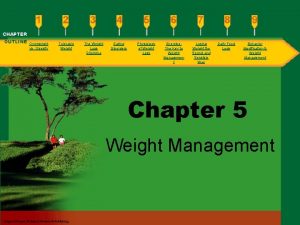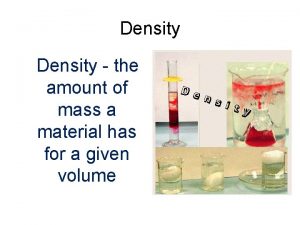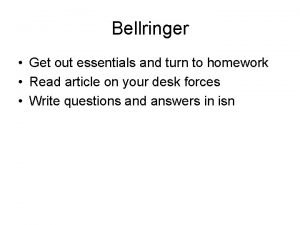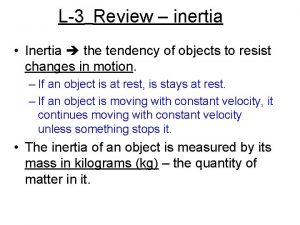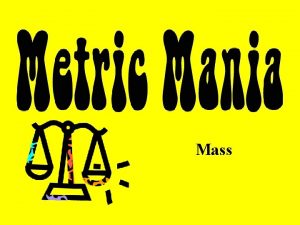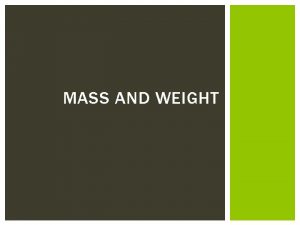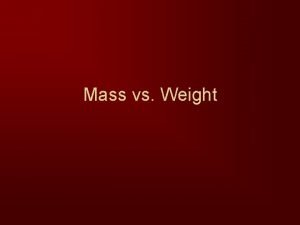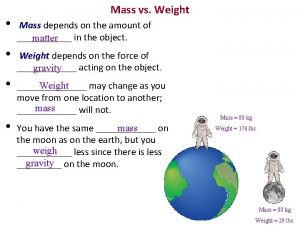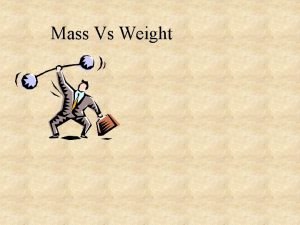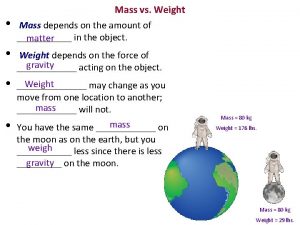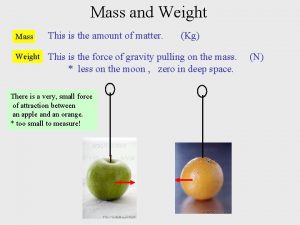Mass vs Weight n n Mass m amount








- Slides: 8

Mass vs Weight n n Mass (m) – amount of matter in an object n It’s what provides the object’s inertia, n It’s a constant no matter where it is measured n Units: grams - think paperclip, kg* - think textbook, (slug) Volume (V) – amount of space object takes up Units: liter, cm 3, (gal, cup, in 3) Recall Density = m/V it is the mass to volume ratio Weight (W) – the force of gravity on an object n it’s how much gravity pulls on the mass of the object n so depending on what the gravity is in your location, your weight will vary n Units: Newton, (lbs) So while m ≠ W, they are proportional if measured in the same location.

The math of mass vs weight: W = mg where on Earth, g = 9. 8 m/s 2 units: N = kg m/s 2 Tools to measure mass vs weight: n Spring scales – contain a spring that extends or compresses depending upon how much push or pull is applied – so they’re location dependent - so they’re good to measure ____ n Ex: n Balances – compare the amount of material in one object with the amount in another – so they’re location independent - so they’re good to measure _____ n Ex: But whether you’re measuring mass or weight is very confusing to keep straight and often messed up in real life – even by people of science! n Ex: “scale” at dr’s office … in lbs “weigh” your sample of ____ in grams in chemistry

Net Force Net force is the vector sum (so both mag & direction) of all the forces acting on an object at one time n Last chapter we called this Resultant Force – F R n If an object’s Fnet = 0, then the object satisfies the condition in Newton’s 1 st Law to be maintaining its state of motion - either at rest or constant velocity… n So we say it is in a state of equilibrium n So the object CAN be moving, just constantly, and n there can be lots of forces acting on it, as long as they add to 0 Let’s look at a few examples:

First consider a book sitting on a table What are the forces acting on it? n The Earth pulls down – force of gravity – W n The table pushes up – force of support – F N [Note: FN is the normal (perpendicular) force – the force of support an object gets from the surface on which it rests – it is always to the surface, so but also ] So, back to the book, which is in equilibrium, since it’s maintaining its state of motion Fnet = FN + W = 0 which means FN = - W they are = magnitudes, but opposite direction!

Now consider a block hung from a string What are the forces acting on it? n The Earth pulls down – force of gravity – W n The string pulling up – force of tension – T [Note: T is the supporting force applied to an object through a long, stringy thing like ] So, back to the block, which is in equilibrium, since it’s maintaining its state of motion Fnet = T + W = 0 which means T = - W they are = mags, but opposite direction again.

Now consider a block hung from two strings What are the forces acting on it? n The Earth pulls down – force of gravity – W n The strings pull up – 2 forces of tension – T 1 & T 2 once again, the block is in equilibrium, so Fnet = T 1 + T 2 + W = 0 which means T 1 + T 2 = - W Are T 1 & T 2 equal to each other? Always? Not necessarily, depends on how / where they’re attached to the object and if the object is made of a uniform material or not.

For the object suspended by the angled scales, both scale’s readings get greater as the angles get wider. n As the angles get bigger, more tension is “lost” to pulling out (horizontally) instead of pulling up to support the weight. n So the total tension, along the angle has to get bigger to make up for that loss. n The readings on the scales will only equal each other if they’re held at equal angles. If the supports are not at equal angles, n the more vertical support has the larger tension since it’s closer to the “up” position so it’s better suited to support the weight of the object.

For the block hung from two scales in a row, Both scales read the weight of the object they hold, with the top one reading just a bit more, as it is holding up the 2 nd scale, as well as the object.
